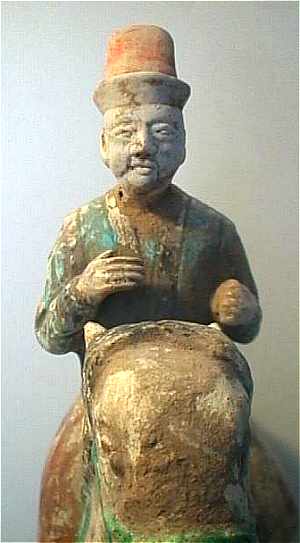
This page is only one of many thousands of Gotheborg.com Help and Information Pages, offering specialized knowledge on Chinese and Japanese Porcelain, including a Glossary, Q&A, Chinese and Japanese Porcelain Marks, Chinese Porcelain Exhibition and Excavation reports etc. For personal help and far more information, join our Discussion Board or use 'Ask a Question' for quick email consultations. For full text and better navigation, use a full-screen device rather than a mobile phone, that offers only limited content.
 I just purchased a Ming horse and rider and I would like to clean off the sand. The seller suggested I leave it as is, but I would like to do a little cleaning. I notice the painted areas ( tunic, black hoves and details) are very chalky and probably not cleanable without removing the pigment but the glazed and unpainted areas would not suffer a little wiping off?
I just purchased a Ming horse and rider and I would like to clean off the sand. The seller suggested I leave it as is, but I would like to do a little cleaning. I notice the painted areas ( tunic, black hoves and details) are very chalky and probably not cleanable without removing the pigment but the glazed and unpainted areas would not suffer a little wiping off?
This is not an easy thing to advise about. Almost all genuine pieces are damaged and quite nicely repaired in China before exported.
The main reason as I see it for a dealer to recommend you not to clean a genuine piece, is that he does not want you to reveal the repairs that most often is hidden under clay that anyway was put on the piece after the repairs was done.
If the piece is not repaired at all, that could of course be good luck, but it could equally well be that the piece is not as old as one would hope. Now (the seller) is well known and seems to know what he is doing, but it is always up to the buyer to believe in his own pieces, and take as good care of it as possibly.
Black "paint" is sometimes retouched by ordinary Chinese brush ink and will of course come off if you clean it.
A ceramic piece in itself will not be damaged by some water and to be perfectly honest I usually put dirty pieces in the bathtub and go over them with a toothbrush and a lukewarm shower just to KNOW what the problems are with a new acquisition. I also want to know where the repairs are - even if I have to have them re-done afterwards.
I have not seen your piece and can't give you any definite advise regarding exactly what to do with it. If it had been painted Han dynasty pottery we were talking about I would suggested you to be utterly careful, since the paint used on those are really very easy to damage.
I advice you to use your judgement and some warm water in equal proportions and tell me what happened :-)
This is the best I can do from this distance - but - be careful!
Thank you for your interest.
Best regards,
Jan-Erik Nilsson
(Picture added later)
I finished cleaning the horse and rider. I did not soak it beause the painted areas would have disolved and I deceided (for now) this was original paint.
It appears to me that after the glaze was fired the piece was cold painted with a cream colored wash and the other colors were added on top of this "wash". I looked carefully to see any variation in the wash for repaired areas but to no avail except around the neck of the rider which was obvious at the start.
I was able to clean the glazed areas with water and light rubbing . The cream colored wash areas I used a razor to scrape the dirt without damaging the wash.This worked well. But the paint layer on top of the wash (like the blue tunic) was hard to scrape without the color flaking off. I was able to expose a little more color but this job was way too delicate for me.
I'm please with how it looks now having removed the dirt I found distracting and leaving enough behind to reflect its origin.